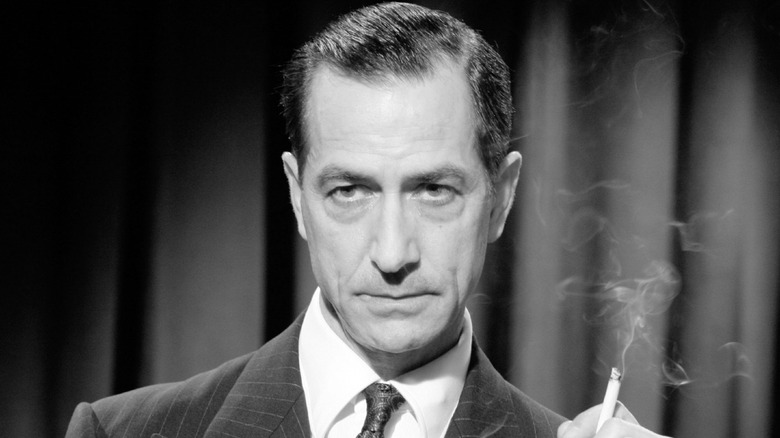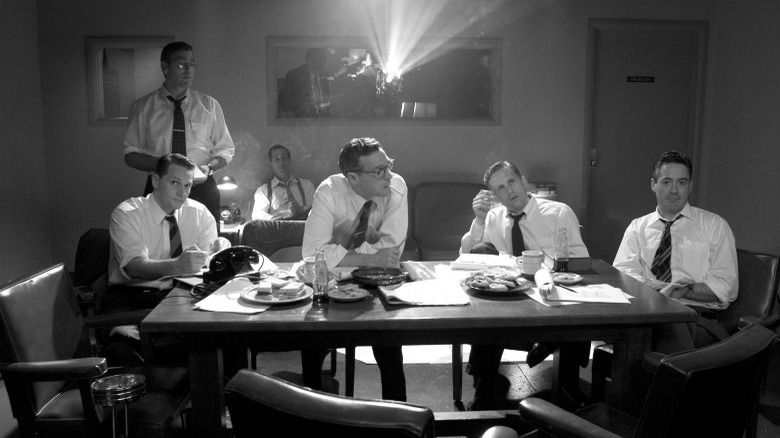George Clooney's Insistence On Black And White Could've Sank Good Night, And Good Luck
Some films are nearly impossible to imagine in anything other than black-and-white. For example, in the case of "Schindler's List," Steven Spielberg shot his harrowing Holocaust drama as though he were a journalist recording the movie's events for the sake of posterity, its monochrome palette inseparable from the real-life historical horrors it depicts.
The same goes for 2005's "Good Night, and Good Luck," a dramatization of radio and TV journalist Edward R. Murrow's war of words with U.S. Senator Joseph McCarthy and his Communist witch-hunts in the 1950s. George Clooney, directing for only the second time after "Confessions of a Dangerous Mind," took a different approach than Spielberg did on "Schindler's List," favoring an observatory, fly-on-the-wall style over hand-held camerawork. Yet, its black-and-white aesthetic is just as essential to the way "Good Night, and Good Luck" tells its story, even if it made it all the harder for Clooney and his producing partner, Grant Heslov, to secure the movie's funding.
In an interview with Hollywood.com, Clooney talked about his decision to make "Good Night, and Good Luck" in black-and-white. He explained:
"Really, the first and only thing to define it was that we were going to use the archival footage, and it would just stand out so badly if we did it any other way. But then Grant and I started talking about knowing that it was going to make it very hard to sell. It made it very hard to sell. It made it shockingly hard to sell."
The film 'looks like a sitcom' in color
When "Good Night, and Good Luck" was moving towards production, Clooney was coming off starring in the lucrative "Ocean's Eleven" and "Ocean's Twelve" in the early 2000s, and "Confessions" was a financial bust in spite of its warm critical reception. With Clooney once again directing, but only playing a supporting role like he did in "Confessions," investors were hesitant to back "Good Night, and Good Luck," espeicially upon learning it would be in black-and-white. As such, Clooney and Heslov were left to raise the movie's $7.5 million budget "pice by piece by piece," the former never wavering in his vision:
"... I only know Murrow and McCarthy in black and white. I've never seen them in color, and I don't know anything about them in color. So I think that you have to film things in the way that you remember them. So I started going through some art films in the beginning, because I thought that maybe I'd shoot it on Super 16 and try to get those lenses and something like that, and I realized [that] was a dumb way to do it."
This was when Clooney looked to films like "Crisis" (the 1939 documentary about the Nazi army's invasion of Czechoslovakia) and "Primary" (the 1960 documentary about the 1960 Wisconsin Democratic primary runoff between John F. Kennedy and Hubert Humphrey) for inspiration, settling on a "fly on the wall kind of look." At the same time, he insisted black-and-white was the "only option" he ever seriously considered:
"It's funny, we shot it on color film because you can use so much less light. I mean, if you're shooting in black and white, it would take us twice as long to light it. So we have a color print of it that we've seen and it is freaky-looking. I mean, it looks like a sitcom. It looks so wrong."
Clooney's instincts were right on the money. Projectors and studio lights never looked as beguiling as they do in "Good Night, and Good Luck," a movie that earned a well-deserved Oscar nod for Robert Elswit's cinematography. The black-and-white visuals also compliment the film's themes, delivering a valuable history lesson about journalistic integrity and the need for those in the media to keep the government in check.

